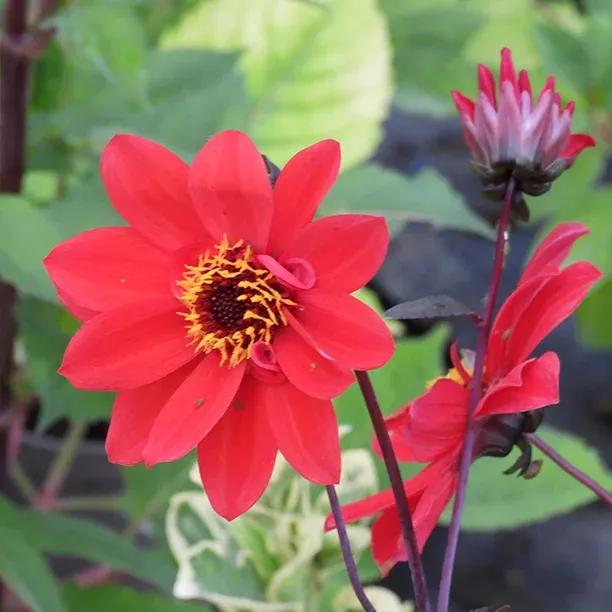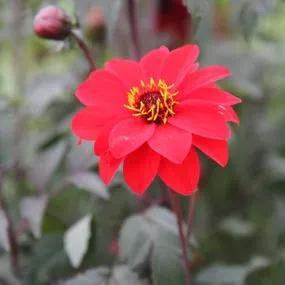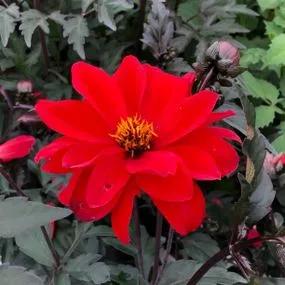Bishop of Llandaff Dahlia Tubers
Honest Delivery Prices- Colour: bright red
- Flower size: 7cm
- Type: Paeony dahlia
- Foliage: deep plum
- Cutting: Yes
- Height/spread: 90cm x 90cm
- Flowering: July to November
- Planting months: end Feb to July
- RHS Award of Garden Merit
Recommended extras
Description
Bishop of Llandaff: Paeony Dahlia Tubers
Bishop of Llandaff has proved hugely popular over the years, spearheading the resurgence in dahlias' popularity in the noughties.
Browse our other Decorative Dahlias, or our full Dahlia range.
The Bishop's aubergine-coloured stems and foliage are a delicious contrast for the bright cherry-red single paeony blooms, a combination that helped to scoop dahlias from the forgotten backwaters of allotments and 'granny's garden' and propel them to the fashionable heights of the Chelsea showgarden. Trends aside, this really is a spectacular and dramatic variety of dahlia, with long, strong stems holding aloft those pure-red single flowers with dark central buttons to perfection – and making it one of the best for picking and bringing indoors. No wonder, then, that it holds the prestigious RHS Award of Garden Merit: it's gorgeous, a great performer, and versatile in the garden.
Features
- Colour: Bright red with bronze centres
- Foliage: Deep plum
- Flower size: 7cm
- Type: Paeony dahlia
- Cutting: Yes
- Height/spread: 90cm x 90cm
- Flowering: July to November
- RHS Award of Garden Merit
- Outdoor Planting Months: March to July
Growing Bishop of Llandaff Dahlias
All dahlias do best in deep rich soil with good drainage in a sunny spot. If it is windy they will need staking. They are greedy, thirsty plants so will need watering in dry spells, and they will always flower that little bit better if there is a bit of soluble food in the watering can once every couple of weeks.
Unlike most dahlias, he is unlikely to need staking, unless you live in a windy spot.
It is generally more convenient to put support stakes in at planting time, rather than leaving it until there is foliage in the way.
Planting Companions for Bishop of Llandaff
At 90cm tall, he is stately but not tricky or top heavy, so it lends itself well to growing either in pots on a sunny patio (plant it with some bronzed grasses for a fabulous effect) or to planting in the mid section of beds and borders. Here it combines fabulously with other 'hot' and exotic companions – think cannas (either with green or bronze foliage), cotinus, ricinus and phormiums (the cream and green varieties look wonderful together). Lilac-coloured asters make a surprisingly wonderful colour combination with the Bishop's red and near-black tones.
Planting Instructions
If you ignore seed, Dahlias can be planted at three stages: as tubers, rooted cuttings and pot-grown plants.
Tubers can be planted at any time from March onwards. The hole should be at least double the diameter of the tuber laid out on the ground. Incorporate about 25% well rotted compost and if drainage is in any way doubtful then add plenty of horticultural grit as well. Plant one tuber per hole, leaving 60-80 cms between plants (depending on final size) and make sure the tuber is covered with 10-12 cms (4-5") of soil. This is important as it will insulate the tuber against frosts in March-May as they will take a couple of months to show.
Rooted cuttings, which are available from early April onwards, will need to be potted up and kept in a sunny and frost free place until they are ready to be planted out in mid May. Their treatment then is the same as for tubers except they are planted level with rather than 10 cms below the surrounding soil level.
Pot grown plants are not delivered until June, and are then planted out immediately in the same way as an established rooted cutting.
The more you deadhead, the more flowers you'll get.
Did You Know?
Bred by Cardiff nurseryman Fred Treseder in 1927, it is the forerunner to a series of Bishops, among them 'Auckland', a deeper red, 'York', a sunny ochre yellow, and 'Canterbury', a rich plum magenta. It is the only member of the collection to hold an RHS AGM.






